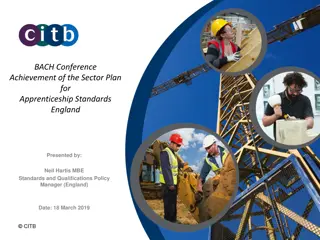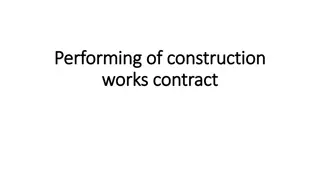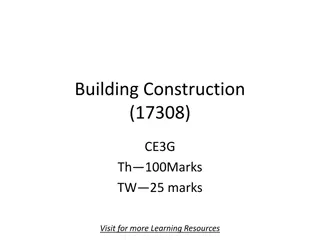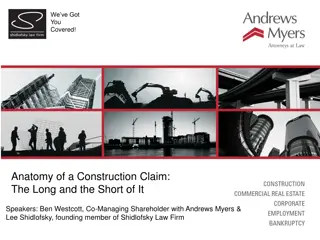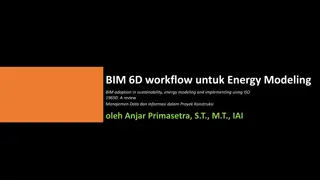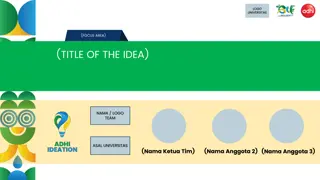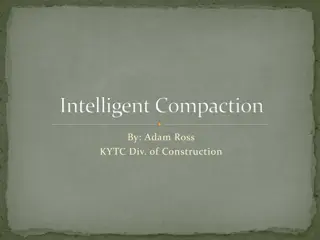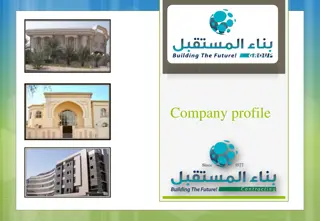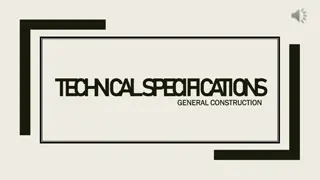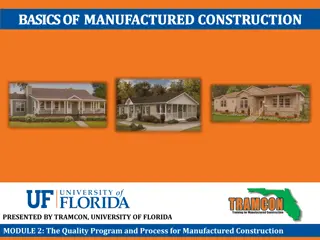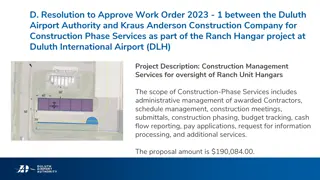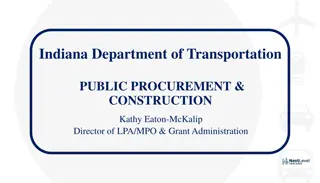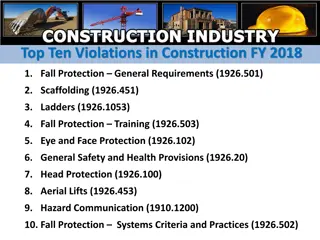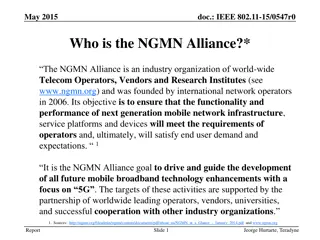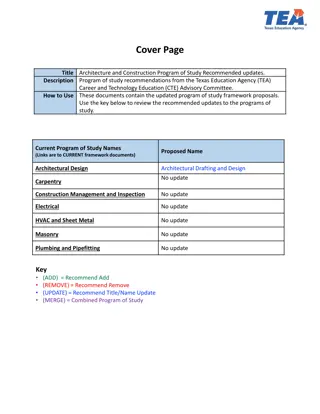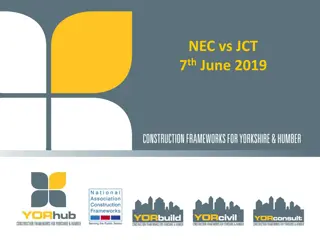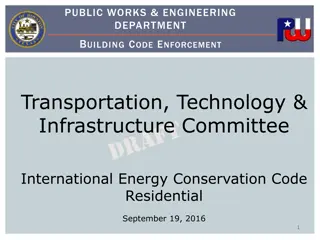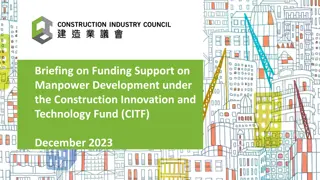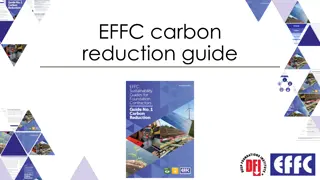Transforming Skills in Construction Industry through Technology
The UK Construction Industry is evolving with technological advancements, particularly in offsite construction methods. This shift requires higher-level skills to drive innovation and sustainability. The sector faces challenges in maintaining skill supplies amidst changing demands but offers growth opportunities. Employer ownership of skills is crucial, highlighting the need for investment in developing skills to meet industry demands.
Download Presentation

Please find below an Image/Link to download the presentation.
The content on the website is provided AS IS for your information and personal use only. It may not be sold, licensed, or shared on other websites without obtaining consent from the author. Download presentation by click this link. If you encounter any issues during the download, it is possible that the publisher has removed the file from their server.
E N D
Presentation Transcript
Technology and Skills in the Construction Industry
Introduction The UK Commission is working to transform the UK s approach to investing in the skills of its people as an intrinsic part of securing jobs and growth. Key to our ambition is the need to encourage greater employer ownership of skills, working to secure long term sustainable partnerships. This slide pack and accompanying evidence report present the case for more employers to invest in developing higher level skills in the Construction Industry. It explores the skills required to meet the demands created by existing and emerging technologies in construction. The main focus is on innovative modern methods of construction, particularly offsite construction. Slide packs and reports are also available for a number of other sectors from: www.ukces.org.uk Each of the sectors are important to the economy in terms of driving up higher level skills through technological advancements. For information about this slide pack and accompanying report please contact: Helen Beck (Helen.Beck@ukces.org.uk) Source information can be found in the notes section of each slide. 2
Storyboard What is the impact of technology on higher level skills needs in the construction industry? The UK construction industry today Technology in the construction industry Offsite construction and drivers influencing take up Future skills and job roles in offsite construction Skills and job roles in offsite construction Implications for the government and construction industry Opportunities and challenges 3
The UK construction industry today The construction industry is a key sector for the UK economy, contributing nearly 90 billion with around 3 million jobs based in construction. The sector is dominated by high levels of self employment, with small and micro businesses accounting for around 95% of the sector, although large companies conduct a disproportionate proportion of the work by value. The global construction market is forecast to grow by over 70% by 2025, with positive signs of growth for the industry in the UK. A key challenge for the sector is to maintain its supply of skills, especially during periods of weak demand. 4
Technology in the construction industry Technological change and the drive towards sustainable and low-carbon construction impacts on skills needs within the industry. High level skills will be needed to drive the development and use of innovative methods of building and the uptake of new technologies and materials. Modern methods of construction (MMC) have the potential to introduce greater efficiencies into the construction process, chiefly through innovations in building design and management for example in adoption of Building Information Modelling (BIM) and in offsite construction processes. This presents a major opportunity to build quicker, to a higher quality, more sustainably, foster innovation and compete on the global market. MMC and the implementation of low carbon systems will require new skills and the adaption and upgrading of the skills of people currently working in the sector. 5
The demand for skills and jobs The study explores the skills required to meet the demands created by the use of offsite construction and the associated impact on job roles. Aims to understand the requirements for high level (and supporting) technical skills, focussing on the supply chain from innovation to development through to use of technologies: Innovation Development Scientific research and development and birth of new technology and methods Use Integration of technology into new products or processes Application of new technology and processes 6
Definition of offsite construction 12% of construction takes place offsite. The most recent estimates (2006) suggest the value of offsite construction specifically the part of the industry using techniques not as yet routinely used in mainstream construction is around 1.5 billion. Four main categories of production are recognised as offsite and these link closely with the manufacturing sector. Offsite includes modules, pods, kit homes, panelised systems and small scale items assembled offsite, such as windows and doors Non- Volumetric pre- assembly volumetric pre- assembly Offsite is most commonly associated with pre-fabricated post war building but is increasingly technology driven Componen tsub- assembly Complete buildings Offsit e 7
Offsite construction: Context and drivers The current recession has supressed the adoption of new technologies but there is a growing acceptance that offsite will increase in importance and is key in realising new opportunities for the construction industry. Drivers influencing the uptake of offsite include: Energy efficiency and sustainability UK Housing shortage Fiscal uncertainty Emerging technologies Ageing workforce Government commitment Offsite is an opportunity to more tightly control costs, respond to Government targets for BIM and energy efficiency, increase efficiency in the build process and improve quality (including site health and safety). Future potential will lie in new technologies with the most commercial application: not necessarily the most innovative or technologically advanced concepts. 8
Current geographical take up of offsite Hubs of activity At present the distribution of offsite construction activity is fairly irregular in terms of its geographical coverage. Some regional differences have been reported in the adoption of offsite: Largely concentrated in the South of England (mainly infrastructure projects such as schools, prisons and hospitals); Scotland has a large volume of timber frame production (as does Wales to an extent); Some evidence to suggest production sites are commonly located in areas with a history of manufacturing; Limited use of offsite method in Northern Ireland. The training offer for offsite is equally as fragmented. 9
Skills for offsite Core skills, knowledge and behaviours Greater focus in future on a knowledge economy and increased interaction between design, construction, manufacturing and engineering disciplines Knowledge, mutual understanding and collaboration Increasing importance of selling the concept of offsite, requiring skills in negotiation and influencing, and technical understanding of the technology Marketing and business case development Management of the interface between offsite and onsite, requiring skills in timing, sequencing and scheduling Project management BIM requires well developed IT skills Knowledge of CAD and automated tools Information technology Requiring skills in phasing of the building process: development, production, utilisation and disposal Planning and design Design to consider repair and maintenance requirements (such as air tightness), particularly critical to maintain energy efficiency A whole life approach 10
Skills and job roles in offsite There is a need for multi-skilled people that are able to understand the interaction between different materials, for example if you put timber and insulation products together, that will require knowledge of factors such as condensation risk. It is less about the individual materials but more about how they interact (Technology developer) Integral link with manufacturing sector Offsite construction is closely associated with manufacturing: relating the build process to manufacturing processes. The management of this process and the interface between the offsite and onsite environment is critical. Key differences between onsite and offsite A key function for the future will be subsequent onsite assembly of offsite manufactured components: rather than construction in the traditional sense. Onsite assembly: Specialists in assembly with a high degree of situational awareness Offsite manufacturing: Specialists skilled in highly repetitive tasks 11
Skills and job roles in offsite Primary, secondary and tertiary job roles required for offsite construction: Primary Secondary Tertiary Bricklayer Carpenter/Joiner Electrician Factory Worker Glazer Heating, Ventilation, Air- Conditioning and Refrigeration Engineer Insulation Installer Masonry Worker Painter/Decorator Plasterer Plumber Roofer Tiler Welder Banker Design Office Administrator General Labourer Insurer Procurer Scheduler Architect BIM Modeller CAD Specialist Consultant Designer Logistics Manager Manufacturer Planner Project Manager Quantity Surveyor Site Supervisor Structural Engineer Supply Chain Manager Technician Technical Salesperson 12
Qualifications and training Concerns with existing education, training and qualification provision: Businesses are developing their own, better solutions (than are offered by many training providers) to deliver training that is bespoke to their needs (Technology innovator) Training is largely conducted in discipline silos Fragmented provision Limited understanding of offsite and some employer resistance to change Disconnection between industry and academia Much training takes place in-house There are not enough design engineers we have been trying to recruit them for months. Because the right skills are not available in the market place the next best thing is to find people with the rightdrive and train them up (Technology developer) Apprenticeship provision focussing on traditional brick and block construction methods Bespoke nature of offsite creates challenges to provision of qualifications and training 13
Example: Timber frame construction One of the main benefits in offsite timber frame construction is the speed at which erection can be carried out. We erected four new classrooms at a school in just less than 11 weeks, as a traditional construction project it would have taken months. Reducing timescales reduces disturbance and hazard (Timber frame manufacturer) Using a prefabricated timber frame is much faster than traditional brick and block construction. At present Scotland maintains the greatest market share of timber framed building at around 40% of all new housing. Waste water heat recovery Procurement Thermal bridging detailing Task management Insulation fitting Cost management Skills required Mechanical ventilation installation Dynamic insulation 14
Timber frame construction: job roles Job roles across all levels: Sales and customer care Design Construction Commerce Contracts Manager Factory Manager Factory Operatives Health and Safety Manager Site Manager and Assistant Site Trades Subcontractor Customer Service Manager Customer Service Operative Marketing Executive Sales Administrator Sales Consultant Sales Manager Architect Architectural Technician Design Consultant Technical Management Timber Frame Designer Buyer Commercial Manager Site Surveyor 15
Example: Straw bale construction Straw bale construction uses straw bales either as a loadbearing structure or as infill to an independent structural system. Straw is warm, durable, renewable and has a negative carbon footprint, absorbing CO2 from the atmosphere. Skills required Emphasis on drawing and planning, as well as fitting and erection onsite. Roles within factories manufacturing panels are commonly filled with those trained in traditional construction methods such as carpentry and joinery. Skills for operational management and business roles include design, marketing and project management. Few universities include modules on prefabrication. 16
Future jobs and skills Design The evolution of job roles Multi-skilling and greater flexibility within Construction/ Manufacturing Engineering job roles is likely for onsite assembly. Offsite could result in multi-skilling becoming more mainstream , with smaller teams being required to assemble components onsite, needing to work more closely together. Occupations will be expected to work more collaboratively, rather than in silos, requiring a clearer knowledge and understanding of other job roles and how they contribute to the holistic offsite project. Roles may become more interlinked particularly at managerial and professional levels, for example, a technical sales role will require an overlap between commercial and technical skills. It is not really about new job roles, as it s merely a transfer of skills from onsite to offsite. This will require people with a very good understanding of how systems are put together onsite (Technology developer) 17
Future jobs and skills Designing for manufacture is a skill that we need to work on. It s a mix really of a traditional design architect and a consulting engineer role. It s all about turning what was a construction process into a manufacturing process User of technology An increased requirement for: Understanding of the design/manufacture/construction interface; Highly developed skills in project management, scheduling and planning; High level skills in marketing, technical sales, influencing and negotiating; Wider adoption of a whole life approach to structures. Offsite makes it more important to consider how work is planned, designed and scheduled. If managers have qualified with high level current qualifications but their expertise is traditionally onsite then it could be very difficult to move to offsite. It s not necessarily the technical skills that are different but more the softer skills including planning, sequencing and link between design and build User of technology 18
Future higher level job roles Greatest impact of offsite is expected for: Architect BIM Modellers Designer Planner Site supervisor/manager or project manager Structural engineer Future demand expected for Design office staff, including BIM modellers and CAD specialists Engineers Project managers Quantity surveyors Schedulers 19
Opportunities The increasing uptake and use of offsite construction can realise the following opportunities for the construction industry Potential to encourage a greater diversity of people, including more young people, into the sector due to weatherproof working conditions and reduction in the use of manual labour; Contribute to environmental and sustainability targets; Respond to housing demand; Realise cost savings through reduced build time; Improve sector productivity and build quality; Improve health and safety; Increase efficiency in the construction process; Greater integration of roles and collaborative working; Expand construction export market to compete. globally Offsite construction carried out in factories can employ many thousands of people who would otherwise be out of work. It opens up a new labour market Technology developer 20
Challenges The future potential of offsite is heavily influenced by a number of competing factors affecting the level of market demand Construction industry can be conservative, leading to reluctance of some builders to adopt MMC/offsite; Need to achieve critical mass in production to realise cost-savings and avoid high capital costs; Risk averse financiers, investors and insurers; Time lag in new technologies reaching the market due to time required to gain certification and the recognition of new technologies; Strong and established international competition; Negative public associations with pre-fabricated structures; Patchy geographical distribution of offsite industry and expertise; Lack of collaboration or direct connection between academia and industry; Fragmented training provision offer; Difficulties in forecasting growth and uptake of offsite technologies. 21
Conclusions: Implications for government and the industry Closer collaborative relationships Greater collaboration between industry and academia to influence the design of training programmes and qualifications. Consideration could be given to the creation of an Offsite Skills Network to bring together academia, research institutes and industry to share knowledge and establish an interface between innovation and commercial application. Stimulating demand Trade Federations and Professional Bodies may wish to work collaboratively on programmes to educate investors, industry stakeholders and home-owners. 22
Conclusions: Implications (continued) Training and qualifications A culture of multi-skilling could be embedded at training stage. For instance, training could seek to equip students with a broader skills and knowledge base about offsite. Training and education providers could consider approaches to offsite training provision in Austria and Germany and identify good practice which can be transferred to the UK. Careers information Advice and guidance to those seeking opportunities in the construction sector that includes consideration of offsite construction job roles could help offer clear pathways to higher level occupations and promote offsite to a greater diversity of people. Continuing Professional Development The construction industry is more likely to be able to take advantage of CPD that can be delivered flexibly (for example via webinars outside of core working hours), and that is not cost prohibitive. 23
01709 774800 info@ukces.org.uk #hightechskills 24





